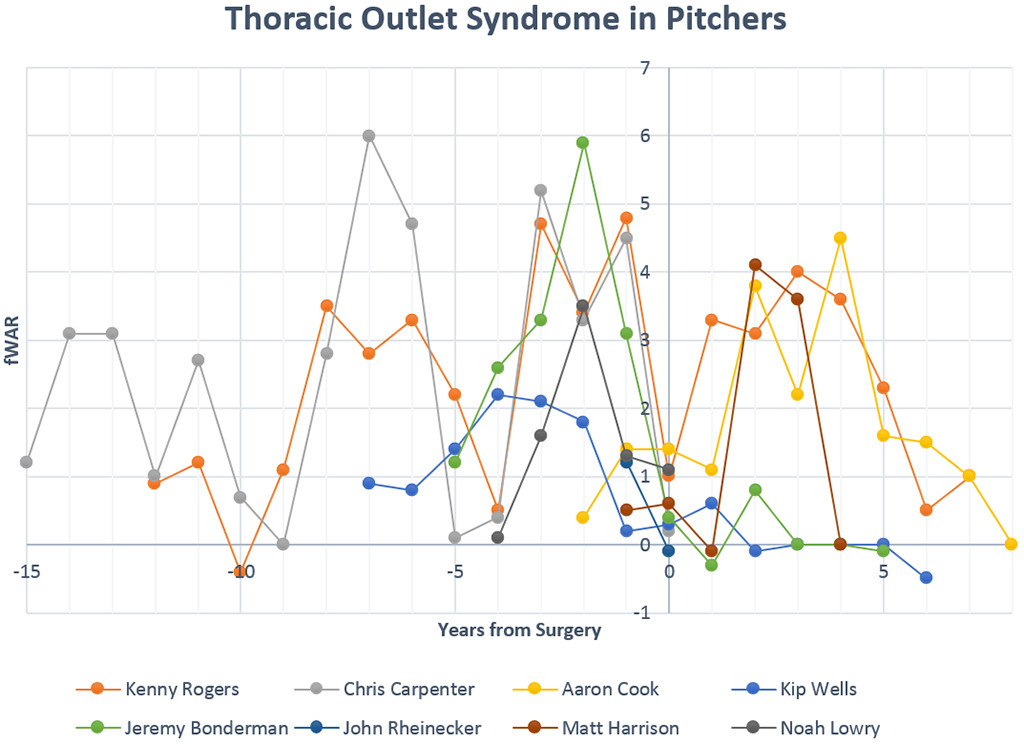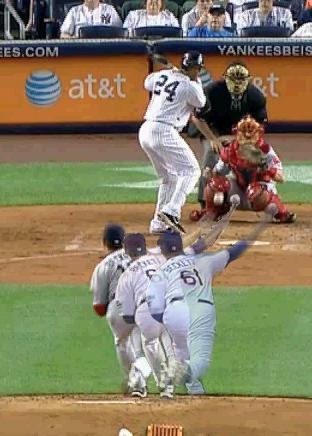| G | IP | K% | BB% | ERA | FIP | xFIP | WAR | |
| MLB | 20 | 115.2 | 22.5% | 8.2% | 2.88 | 4.33 | 3.73 | 0.2 |
What Happened In 2014: Contributed, when nobody expected it.
Entering the season, nobody expected much out of Josh Beckett. He ended 2013 with major surgery for thoracic outlet syndrome, removing a rib to relieve nerve pressure in his pitching shoulder. It was a major procedure, one that ends careers for a lot of pitchers. Before the season, I wrote about the history of players who received the same surgery. I was able to find eight previous examples in pitchers, and the success was mixed:
This chart shows the years away from the surgery on the X axis, and the fWAR by season on the Y axis. X=0 is the year in which the surgery took place (or the last season before the surgery). Negative X values are years before the surgery, and positive X values are years after the surgery.
Among those spaghetti lines, there were a lot of cautionary tales. Three of the eight never pitched in the majors again. Another two were never effective in the majors again. The other three went on to have successful seasons following the surgery, but a 37.5% success rate is pretty scarily low. Shaun Marcum was not included in the study, as he had the surgery around the same time as Beckett, only managed 17 major league innings in 2014. There wasn’t a lot of hope.
However, during spring training, we found some room for optimism in Beckett’s pitching mechanics. After making this comparison GIF:
GIF Link – click for larger
And making this overlay:
The overall conclusion was about as encouraging as it could be. Beckett was standing more upright, shoulders and head above where it was during his thoracic outlet syndrome years (middle on the still overlay, left on GIF). A change like that can be significant, and it brought happy thoughts, especially considering how bleak things looked a few months before.
Beckett closed his thumb in a door shortly after that post, then sprained his ankle while rehabbing, so he didn’t make his debut until April 9th against Detroit. His initial run of starts from April to June were extremely useful, especially thanks to the resurgence of his curveball. Per Pedro Moura’s excellent profile on the pitch, the suggestion to throw the pitch more came from A.J. Ellis. Beckett finished the season throwing his curve 30.8% of the time, second in baseball to A.J. Burnett among pitchers with at least 100 innings pitched.
One of Beckett’s biggest early speedbumps was in mid-May in New York. The Dodgers won the game, but Beckett only lasted five-plus innings while allowing four runs. What was his problem? He was throwing pitches
Of course, we won’t remember that start. We’ll remember the next one. On May 25th, 12 starts before retirement, Beckett pitched a no-hitter. It was the first for the Dodgers since 1996 (and the last for three weeks). Dustin had the recap, and walked through the impressive and historic afternoon:
Beckett was at 90 pitches through six innings. Questions were raised about how long the Don Mattingly would let him go if he were throwing a no-hitter. Well, Beckett needed 38 pitches to complete the no-hitter, with most of those coming in the ninth inning. He retired 23 batters in a row at one point. His career-high in pitches before today was 126.
There weren’t many great defensive plays in the game, as Beckett didn’t allow much hard contact all day. But with Ramirez and Kemp out, this was about the best Dodger defense that could have been on the field. Erisbel Arruebarrena (who went 2-for-3 with his first RBI) shored up the infield defense and made a couple of tough plays at shortstop look easy.
Beckett looked like his old self, working consistently in the low-90s with a plus-curveball. He used his entire bag of tricks to keep the Phillies’ offense from doing much of anything against them. He issued two walks early and one to Jimmy Rollins in the ninth inning, but none of them (obviously) came back to hurt him.
Beckett continued his run of success/luck well into the following month. In late June, Mike was starting to wonder if Beckett could make the all-star team. He didn’t, and that marked the end of the dream run. Beckett was first placed on the disabled list with a hip impingement in early July. He returned shortly after the all-star break, but struggled and returned to the disabled list in August, adding a groin injury to his continuing hip woes (impingement upgraded to torn labrum). He was out for the remainder of the season, and announced his retirement shortly after the year ended.
Beckett’s ERA was not going to stay 1.46 under his FIP (third-highest in baseball last year) if he pitched longer. His BABIP would have risen from .257, and his strand rate would have fallen from 85.2%. But getting hung up on that does Beckett a disservice. It was amazing that he pitched at all, let alone pitching well (using any definition). Injuries eventually got the best of him, but it was still a season to remember.
2015 Status: Retired.
 Dodgers Digest Los Angeles Dodgers Baseball Blog
Dodgers Digest Los Angeles Dodgers Baseball Blog

